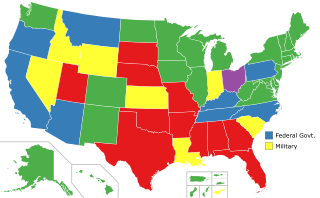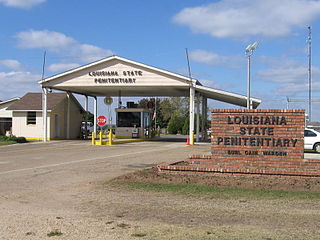Related Research Articles

A gas chamber is an apparatus for killing humans or other animals with gas, consisting of a sealed chamber into which a poisonous or asphyxiant gas is introduced. Poisonous agents used include hydrogen cyanide and carbon monoxide.

In the United States, capital punishment is a legal penalty throughout the country at the federal level, in 27 states, and in American Samoa. It is also a legal penalty for some military offenses. Capital punishment has been abolished in 23 states and in the federal capital, Washington, D.C. It is usually applied for only the most serious crimes, such as aggravated murder. Although it is a legal penalty in 27 states, 20 states currently have the ability to execute death sentences, with the other seven, as well as the federal government, being subject to different types of moratoriums.

Capital punishment is a legal penalty in the U.S. state of Louisiana.

In the U.S. state of California, capital punishment is not allowed to be carried out as of March 2019, because executions were halted by an official moratorium ordered by Governor Gavin Newsom. Before the moratorium, executions had been frozen by a federal court order since 2006, and the litigation resulting in the court order has been on hold since the promulgation of the moratorium. Thus, there will be a court-ordered moratorium on executions after the termination of Newsom's moratorium if capital punishment remains a legal penalty in California by then.

Capital punishment is a legal penalty in the U.S. state of Ohio, although all executions have been suspended indefinitely by Governor Mike DeWine until a replacement for lethal injection is chosen by the Ohio General Assembly. The last execution in the state was in July 2018, when Robert J. Van Hook was executed via lethal injection for murder.
Capital punishment is a legal penalty in the U.S. state of Utah.

Capital punishment was abolished via the legislative process on May 2, 2013, in the U.S. state of Maryland.

The Oklahoma State Penitentiary, nicknamed "Big Mac", is a prison of the Oklahoma Department of Corrections located in McAlester, Oklahoma, on 1,556 acres (6.30 km2). Opened in 1908 with 50 inmates in makeshift facilities, today the prison holds more than 750 male offenders, the vast majority of which are maximum-security inmates. They also hold many death row prisoners.

Capital punishment in Alabama is a legal penalty. Alabama has the highest per capita capital sentencing rate in the United States. In some years, its courts impose more death sentences than Texas, a state that has a population five times as large. However, Texas has a higher rate of executions both in absolute terms and per capita.
Capital punishment is a legal penalty in the U.S. state of Idaho.
Capital punishment is a legal penalty in the U.S. state of Wyoming.

Capital punishment is a legal penalty in the U.S. state of Mississippi.
Capital punishment is a legal penalty in the U.S. state of Arizona. After the execution of Joseph Wood in 2014, executions were temporarily suspended but resumed in 2022. On January 23, 2023, newly inaugurated governor Katie Hobbs ordered a review of death penalty protocols and in light of that, newly inaugurated attorney general Kris Mayes issued a hold on any executions in the state.
Capital punishment is a legal penalty in the U.S. state of South Carolina. Between 1718 and 2021, more than 680 people have been executed in South Carolina. After the nationwide capital punishment ban was overturned in 1976, South Carolina has executed 43 people.
Capital punishment is a legal punishment in Tennessee.
Richard Eugene Glossip is an American prisoner currently on death row at Oklahoma State Penitentiary after being convicted of commissioning the 1997 murder of Barry Van Treese. The man who murdered Van Treese, Justin Sneed, had a "meth habit" and agreed to plead guilty in exchange for testifying against Glossip. Sneed received a life sentence without parole. Glossip's case has attracted international attention due to the unusual nature of his conviction, namely that there was little or no corroborating evidence, with the first case against him described as "extremely weak" by the Oklahoma Court of Criminal Appeals.
Capital punishment is a legal penalty in the U.S. state of Kentucky.

The execution of John Grant took place in the U.S. state of Oklahoma by means of lethal injection. Grant was sentenced to death for the 1998 murder of prison cafeteria worker Gay Carter.

Glossip v. Chandler is a United States District Court for the Western District of Oklahoma case in which the plaintiffs challenged the State of Oklahoma's execution protocol. The initial lawsuit, Glossip v. Gross, rose to the United States Supreme Court in 2015 at the preliminary injunction stage and involved an earlier version of Oklahoma's lethal injection protocol. The case was reopened in the District Court in 2020 following an end to Oklahoma's moratorium on executions.

The execution of Kenneth Eugene Smith took place in the U.S. state of Alabama by means of nitrogen hypoxia. It was the first execution in the world to use this particular method.
References
- ↑ Executions in the United States, by state
- ↑ State Execution Rates
- ↑ A Guilty Man
- ↑ Haynes, Danielle (June 10, 2022). "Oklahoma AG seeks to schedule 25 executions". United Press International . Retrieved June 11, 2022.
- ↑ "§21-701.11. Instructions - Jury findings of aggravating circumstance". law.justia.com. Retrieved June 2, 2016.
- ↑ Oklahoma Statutes § 21-701.12
- ↑ 21 Okl. St. Ann. § 1114 and 21 Okl. St. Ann. § 1115
- ↑ 21 Okl. St. Ann. § 745(A)
- ↑ 10 Okl. St. Ann. § 7115(I)
- ↑ "Section VI-10". Oklegal.onenet.net. Retrieved 2016-07-21.
- 1 2 "Clemency | Death Penalty Information Center". Deathpenaltyinfo.org. Archived from the original on 2008-06-18. Retrieved 2016-07-21.
- ↑ "Nitrogen gas execution: Kenneth Smith convulses for four minutes in Alabama death chamber". Montgomery Advertiser. Retrieved 2024-01-29.
- ↑ "The Dawn of a New Form of Capital Punishment". Time. April 17, 2015.
- ↑ Mims, Divina (December 16, 2010). "Death row inmate executed using pentobarbital in lethal injection". CNN. Retrieved December 16, 2010.
- ↑ Brandes, Heidi (5 September 2014). "Oklahoma to halt execution until new protocols in place: governor". Reuters. Archived from the original on 10 September 2014. Retrieved 10 September 2014.
- ↑ Stern, Jeffrey E. (June 2015). "The Cruel and Unusual Execution of Clayton Locket; The untold story of Oklahoma's botched lethal injection—and America's intensifying fight over the death penalty". The Atlantic. Retrieved 2016-10-05.
- ↑ Murphy, Sean (October 29, 2021). "Oklahoma executes inmate who dies vomiting and convulsing". Associated Press . Retrieved October 29, 2021.
- ↑ Reardon, Sophie; Sostre, Bonita (October 29, 2021). "Inmate vomits, convulses during Oklahoma execution, its first in six years". CBS News . Retrieved October 30, 2021.
- ↑ Marcus, Josh (October 30, 2021). "Oklahoma defends first execution in six years, while critics say it was 'torture'". The Independent . Retrieved October 31, 2021.
- ↑ "Grand jury completes scathing report on Department of Corrections, recommends nitrogen gas as new execution method". KFOR.com Oklahoma City. 2016-05-19. Retrieved 2021-08-27.
- ↑ "Oklahoma Attorney general says state will resume executions". nypost.com. 13 February 2020. Retrieved March 22, 2020.
- ↑ "Oklahoma Votes to Add Death Penalty to Its Constitution". time.com. 9 November 2016. Retrieved April 9, 2017.
- ↑ Murphy, Sean (2022-01-11). "Oklahoma Death Row Inmates Seek Firing Squad As Alternative To Lethal Injection". HuffPost. Archived from the original on 2022-01-11. Retrieved 2022-01-11.
- ↑ Murphy, Sean (January 28, 2022). "Oklahoma executes man for 2001 slayings of 2 hotel workers". ABC News . Retrieved January 28, 2022.
- ↑ Murphy, Sean (February 17, 2022). "Oklahoma executes man for role in 2005 quadruple slaying". Associated Press . Retrieved February 17, 2022.
- ↑ "Inmates Sentenced to Death". Oklahoma Department of Corrections . Retrieved 16 June 2023.